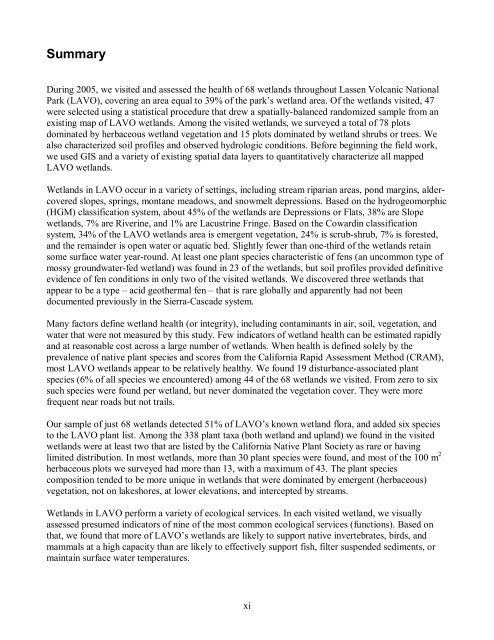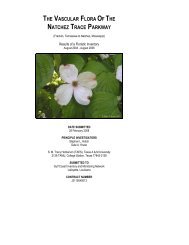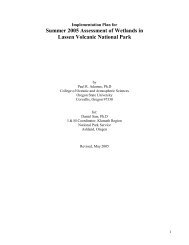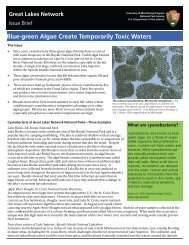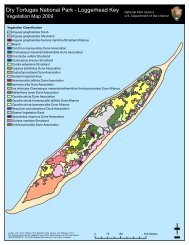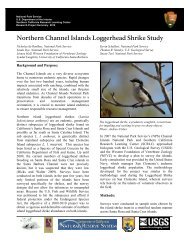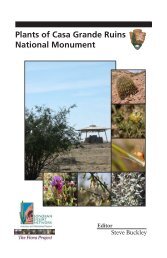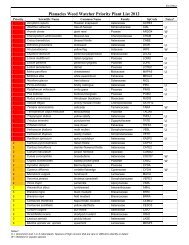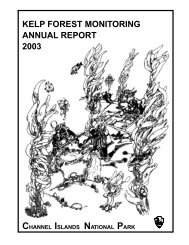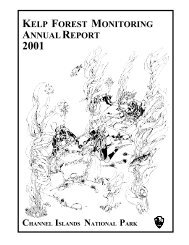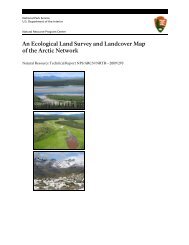Wetlands of Lassen Volcanic National Park - NPS Inventory and ...
Wetlands of Lassen Volcanic National Park - NPS Inventory and ...
Wetlands of Lassen Volcanic National Park - NPS Inventory and ...
You also want an ePaper? Increase the reach of your titles
YUMPU automatically turns print PDFs into web optimized ePapers that Google loves.
Summary<br />
During 2005, we visited <strong>and</strong> assessed the health <strong>of</strong> 68 wetl<strong>and</strong>s throughout <strong>Lassen</strong> <strong>Volcanic</strong> <strong>National</strong><br />
<strong>Park</strong> (LAVO), covering an area equal to 39% <strong>of</strong> the park’s wetl<strong>and</strong> area. Of the wetl<strong>and</strong>s visited, 47<br />
were selected using a statistical procedure that drew a spatiallybalanced r<strong>and</strong>omized sample from an<br />
existing map <strong>of</strong> LAVO wetl<strong>and</strong>s. Among the visited wetl<strong>and</strong>s, we surveyed a total <strong>of</strong> 78 plots<br />
dominated by herbaceous wetl<strong>and</strong> vegetation <strong>and</strong> 15 plots dominated by wetl<strong>and</strong> shrubs or trees. We<br />
also characterized soil pr<strong>of</strong>iles <strong>and</strong> observed hydrologic conditions. Before beginning the field work,<br />
we used GIS <strong>and</strong> a variety <strong>of</strong> existing spatial data layers to quantitatively characterize all mapped<br />
LAVO wetl<strong>and</strong>s.<br />
<strong>Wetl<strong>and</strong>s</strong> in LAVO occur in a variety <strong>of</strong> settings, including stream riparian areas, pond margins, alder<br />
covered slopes, springs, montane meadows, <strong>and</strong> snowmelt depressions. Based on the hydrogeomorphic<br />
(HGM) classification system, about 45% <strong>of</strong> the wetl<strong>and</strong>s are Depressions or Flats, 38% are Slope<br />
wetl<strong>and</strong>s, 7% are Riverine, <strong>and</strong> 1% are Lacustrine Fringe. Based on the Cowardin classification<br />
system, 34% <strong>of</strong> the LAVO wetl<strong>and</strong>s area is emergent vegetation, 24% is scrubshrub, 7% is forested,<br />
<strong>and</strong> the remainder is open water or aquatic bed. Slightly fewer than onethird <strong>of</strong> the wetl<strong>and</strong>s retain<br />
some surface water yearround. At least one plant species characteristic <strong>of</strong> fens (an uncommon type <strong>of</strong><br />
mossy groundwaterfed wetl<strong>and</strong>) was found in 23 <strong>of</strong> the wetl<strong>and</strong>s, but soil pr<strong>of</strong>iles provided definitive<br />
evidence <strong>of</strong> fen conditions in only two <strong>of</strong> the visited wetl<strong>and</strong>s. We discovered three wetl<strong>and</strong>s that<br />
appear to be a type – acid geothermal fen – that is rare globally <strong>and</strong> apparently had not been<br />
documented previously in the SierraCascade system.<br />
Many factors define wetl<strong>and</strong> health (or integrity), including contaminants in air, soil, vegetation, <strong>and</strong><br />
water that were not measured by this study. Few indicators <strong>of</strong> wetl<strong>and</strong> health can be estimated rapidly<br />
<strong>and</strong> at reasonable cost across a large number <strong>of</strong> wetl<strong>and</strong>s. When health is defined solely by the<br />
prevalence <strong>of</strong> native plant species <strong>and</strong> scores from the California Rapid Assessment Method (CRAM),<br />
most LAVO wetl<strong>and</strong>s appear to be relatively healthy. We found 19 disturbanceassociated plant<br />
species (6% <strong>of</strong> all species we encountered) among 44 <strong>of</strong> the 68 wetl<strong>and</strong>s we visited. From zero to six<br />
such species were found per wetl<strong>and</strong>, but never dominated the vegetation cover. They were more<br />
frequent near roads but not trails.<br />
Our sample <strong>of</strong> just 68 wetl<strong>and</strong>s detected 51% <strong>of</strong> LAVO’s known wetl<strong>and</strong> flora, <strong>and</strong> added six species<br />
to the LAVO plant list. Among the 338 plant taxa (both wetl<strong>and</strong> <strong>and</strong> upl<strong>and</strong>) we found in the visited<br />
wetl<strong>and</strong>s were at least two that are listed by the California Native Plant Society as rare or having<br />
limited distribution. In most wetl<strong>and</strong>s, more than 30 plant species were found, <strong>and</strong> most <strong>of</strong> the 100 m 2<br />
herbaceous plots we surveyed had more than 13, with a maximum <strong>of</strong> 43. The plant species<br />
composition tended to be more unique in wetl<strong>and</strong>s that were dominated by emergent (herbaceous)<br />
vegetation, not on lakeshores, at lower elevations, <strong>and</strong> intercepted by streams.<br />
<strong>Wetl<strong>and</strong>s</strong> in LAVO perform a variety <strong>of</strong> ecological services. In each visited wetl<strong>and</strong>, we visually<br />
assessed presumed indicators <strong>of</strong> nine <strong>of</strong> the most common ecological services (functions). Based on<br />
that, we found that more <strong>of</strong> LAVO’s wetl<strong>and</strong>s are likely to support native invertebrates, birds, <strong>and</strong><br />
mammals at a high capacity than are likely to effectively support fish, filter suspended sediments, or<br />
maintain surface water temperatures.<br />
xi


